Colorado blue spruce, or blue spruce, is an attractive tree often used for Christmas trees or as ornamentals, particularly in the eastern United States and Europe. It is the official state tree of both Colorado and Utah. Leaves (needles) are 1-1 1/2 inches long on lower branches but somewhat shorter on upper branches. They are 4-sided and have a very sharp point on the end.
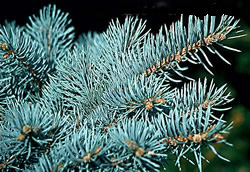
This tree is familiar to most people as a landscape plant, especially in its striking
blue form. Although it is native to only a small area of the Rocky Mountains, it has adapted to a wide range of soils and to most of the northern part of the United States and lower Canada. In its favor is good form, good response to light shearing, and rapid growth after it reaches 3 feet in height.
More Trees
White spruce is a medium-sized conifer found in northeastern United States and throughout Canada.
White spruce has a cone-shaped crown, and when grown in the open develops a conical crown which extends nearly to the ground. This habit along with the spreading branches give it a nice appearance for use as an ornamental.
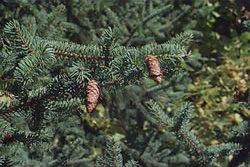
Leaves (needles) are needle-shaped, and are often somewhat crowded on the upper half of the
branch lets. Needles are usually 1/2 to 3/4 inch long, blunt at the tip and green to bluish-green in color. Typically, needles are 4 angled (4-sided) and are present on short twig-like structures on the stem.
As a Christmas tree, white spruce has excellent foliage color, short stiff needles and a good natural shape. Needle retention is better than some of other spruce species.
More Trees
This is definitely a cold-climate tree and does well only where winters are cold and summer are cool. To many easterners a balsam fir is the only true Christmas tree. It is naturally cone shaped, with needles that are rich green on top and silvery white underneath. They last well, too, but their rich fragrance is the tree's outstanding
quality. Balsam grows best on soils that are not to acidic, and it even does well on soils that are fairly moist, as long as they are supplied with nitrogen.
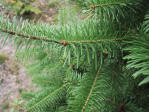
As a Christmas tree, balsam fir has several desirable properties. It has a dark-green appearance, long-lasting needles, and attractive form. It also retains its pleasing fragrance. Nine to ten years in the field are required to produce a 6-7 foot tree.
More Trees
Leaves (needles) are soft, flexible and bluish-green to silver green in color
and are regularly arranged in bundles of five. Needles are 2 1/2-5 inches long
and are usually shed at the end of the second growing season. Both male and
female flowers (strobili) occur on the same tree, with pollination occurring in
spring. Cones are 4-8 inches in length, usually slightly curved and mature at
the end of the second season. Cone scales are rather thin and never have
prickles. Cones also have exudations of a fragrant gummy resin.
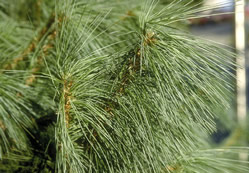
More Trees
Fraser Fir
Sold out.
Leaves (needles) are flattened, dark-green with a medial groove on the upper
side and two broad silvery-white bands on the lower surface. These bands consist
of several rows of stomata (pores). Leaves are 1/2 to one inch long, have a
broad circular base, and are usually dark green on the upper surface and lighter
on the lower surface. On lower branches, leaves are two-ranked (occurring in two
opposite rows). On upper twigs, leaves tend to curl upward forming a more
"U-shaped" appearance.

More Trees
Concolor Fir
White fir, also commonly called concolor fir, is native to the western United States. Needles are usually 1/2 to 1 1/2 inch long, pointed or notched at the tip, bluish-green when young turning dull green with age. Typically, they are flat, without stalks. The bark on younger trees is thin, smooth, gray with numerous resin-bearing pockets. Older bark is thicker, reddish-brown to light gray and broken into irregular, flattened scales. As a Christmas tree, white fir has good foliage color, a pleasing natural shape and aroma, and good needle retention.
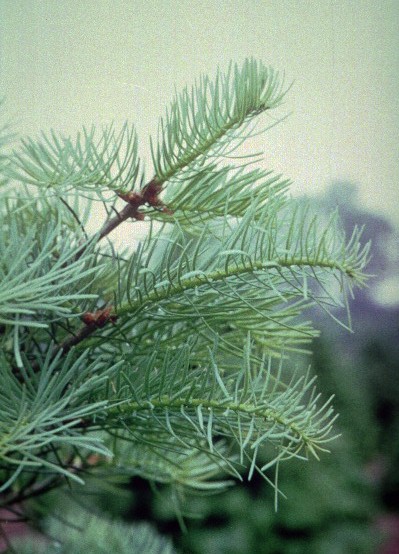
More Trees